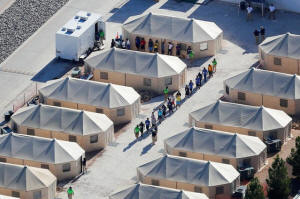|
Tech issues plague U.S. web portal
tracking separated children
 Send a link to a friend
Send a link to a friend
 [July 11, 2018]
By Reade Levinson, Kristina Cooke and Yeganeh Torbati [July 11, 2018]
By Reade Levinson, Kristina Cooke and Yeganeh Torbati
(Reuters) - In late June, attorney
Sebastian Harley tried to log into a U.S. government web portal to check
on a Guatemalan child who had been separated from his parent at the
border. He got an error message saying there were too many users.
“I just couldn’t get in,” he said. “The system appeared to be down.”
It was not an isolated incident. From the moment it went online in
January of 2014, the computer system designed to track unaccompanied
immigrant children and process their release has created headaches for
the shelter staff, government employees and others who use it, according
to interviews with a dozen current and former users, government reports,
and congressional testimony.
Users described a frustrating array of issues, including that the portal
could only handle a limited number of users at once without crashing,
lost saved data, had poor searchability and required significant manual
work for even small updates.

Now that system, operated by the Office of Refugee Resettlement (ORR)
and known as the UAC portal, has become a key part of the effort to
track thousands of children under government supervision who were
separated from their parents by immigration officials in recent months.
It is being used by government employees, legal service providers,
shelter workers and call center operators looking to answer parents’
questions about their children’s whereabouts.
But the system was set up to track unaccompanied minors rather than
those separated from their parents by border officials, and it has
little ability to interact with the separate database used by
Immigration and Customs Enforcement to track the children's parents,
users said, complicating efforts to easily link family members.
One case worker involved in reunification efforts said she has used the
portal regularly over the past eight months, and that "for some weeks
during that period, it was making our daily work impossible."
A Department of Health and Human Services (HHS) official said the UAC
portal is what call center workers use to locate children in ORR
custody. The agency is “constantly making improvements to the portal,”
he said, but did not provide further details.
Paige Austin, an attorney with the New York Civil Liberties Union, said
she and her colleagues have documented numerous cases this year in which
issues with the UAC portal delayed the release of children from ORR
custody.
“We definitely observed that issues with the portal were an impediment
to finalizing release and referrals,” said Austin.
The portal’s shortcomings are just one of many challenges that have
cropped up as the government races against court-imposed deadlines to
reunite children and families it has separated at the border.

Federal judge Dana Sabraw ordered the reunifications after the American
Civil Liberties Union filed a San Diego lawsuit challenging the
government's policy of separating children from their parents. In his
order setting a July 26 deadline for reuniting all separated families,
he noted that while the government routinely catalogs detainees’
possessions, it “has no system in place to keep track of, provide
effective communication with, and promptly produce alien children.”
A TRAIL OF PROBLEMS
Issues with the computer system have been repeatedly documented.
In October 2015, HHS data analysts told a U.S. Senate subcommittee that
the portal had shortcomings the agency was “working to fix.” Users had
to be extremely specific when entering a name or address, for example:
an entry for a street name including “Pl” is not the same thing as
“Place.” And a minor misspelling of a name could mean a search would
come back with no results, they told the committee.
The next year, a report by the Government Accountability Office (GAO)
found that ORR still did not have the processes in place to ensure data
were reliable, systematically collected, and compiled in a useful
manner.
Michael Weiss, chief operating officer of the system’s initial developer
Patriot LCC, said the government’s needs changed drastically from
September 2013 when his company won the contract to build the first
iteration of the system.
“They gave us very minimal requirements to get something up and running
that they could at least use internally in their office,” he said.
[to top of second column]
|

Immigrant children now housed in a tent encampment under the new
"zero tolerance" policy by the Trump administration are shown
walking in single file at the facility near the Mexican border in
Tornillo, Texas, U.S. June 19, 2018. REUTERS/Mike Blake/File Photo

After the system was launched, “they kept changing their
requirements,” said Weiss, necessitating frequent updates. Still, he
said, the company was unaware of any issues with the system beyond
the usual software bugs. From 2013 to 2016, when Patriot's contract
ended, the company met or exceeded ORR’s requirements, he said,
according to evaluations it received.
In mid-2016, a government agency known as 18F, which does
small-scale technology projects, was brought in to help strategize
how to manage increasing demands on the system and address its
problems.
The home page took minutes to load, even without heavy traffic, and
the system would crash if too many people logged on at once, said
former 18F developer Kane Baccigalupi. “There were really
significant performance problems.”
For one thing, she said, case workers who wanted to add to or fix a
child’s record had to copy what was in the fields before they went
into edit or else information would be deleted.
Baccigalupi said her team ran out of time to address system-wide
problems and instead focused on building a feature that allowed
users to check bed capacity. When the developers’ contract ended
around the time of the 2016 presidential election it was still “not
a working system,” according to Baccigalupi.
The HHS official said upgrades to the portal were made in 2016 to
refine the process for entering addresses and add the bed capacity
feature.

PROBLEMS PERSISTED
A former government contractor who used the portal daily from when
it launched until June 2017 said the system made it difficult to
find children with multiple last names, which are common in Latin
America, or to search for different spellings of names such as
Cortez and Cortes.
“If you have the wrong one, it’s not going to find anything,” he
said. He described working around the system by putting in different
combinations of names until he found the child he was looking for.
When he went to edit or update a child’s file, he said, he learned
to save the information in a separate document on his computer in
case the system crashed or the information did not upload correctly.
“I wanted a Word document to make sure I had it,” he said.
Currently, Pennsylvania-based Applied Intellect has the contract for
operating the portal. The company referred requests for comment to
HHS, and it is unclear what work has been done since Trump took
office in January 2017.
A GAO report this year noted some improvements by ORR in
“systematically collecting information that can be used internally
and shared, as appropriate, with external agencies,” such as more
timely and complete record keeping of the quality of care children
received after they leave ORR facilities.
But the report also found that as of April, “case management
functionality had not yet been built into ORR’s web-based portal,” a
crucial component for tracking the care of children.
Kathryn Larin, who directs the GAO’s education, workforce, and
income security team, said that as of April 2018, case workers
maintained paper files for children and the data were not always
entered into the UAC portal. Case workers often collected
information in their files which did not fit readily into the
portal’s data fields, she said.

A day after attorney Sebastian Harley was unable to log in to the
portal, his colleague was able to get an update on the Guatemalan
boy - by calling the child’s case worker.
(Editing by Sue Horton)
[© 2018 Thomson Reuters. All rights
reserved.]
Copyright 2018 Reuters. All rights reserved. This material may not be published,
broadcast, rewritten or redistributed.
Thompson Reuters is solely responsible for this content. |